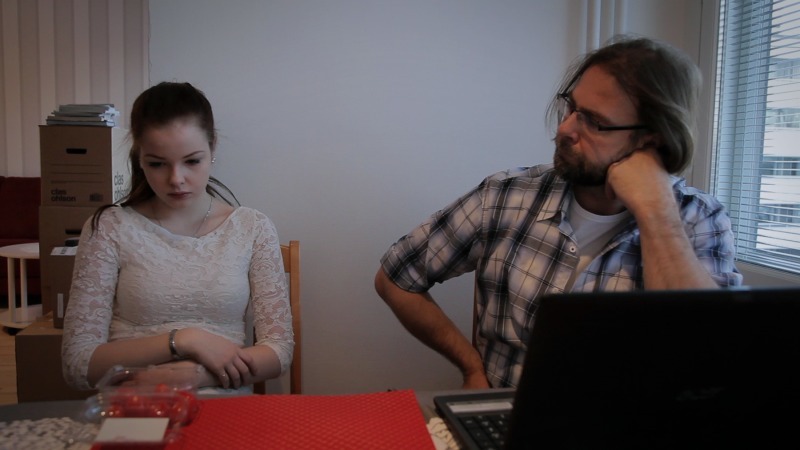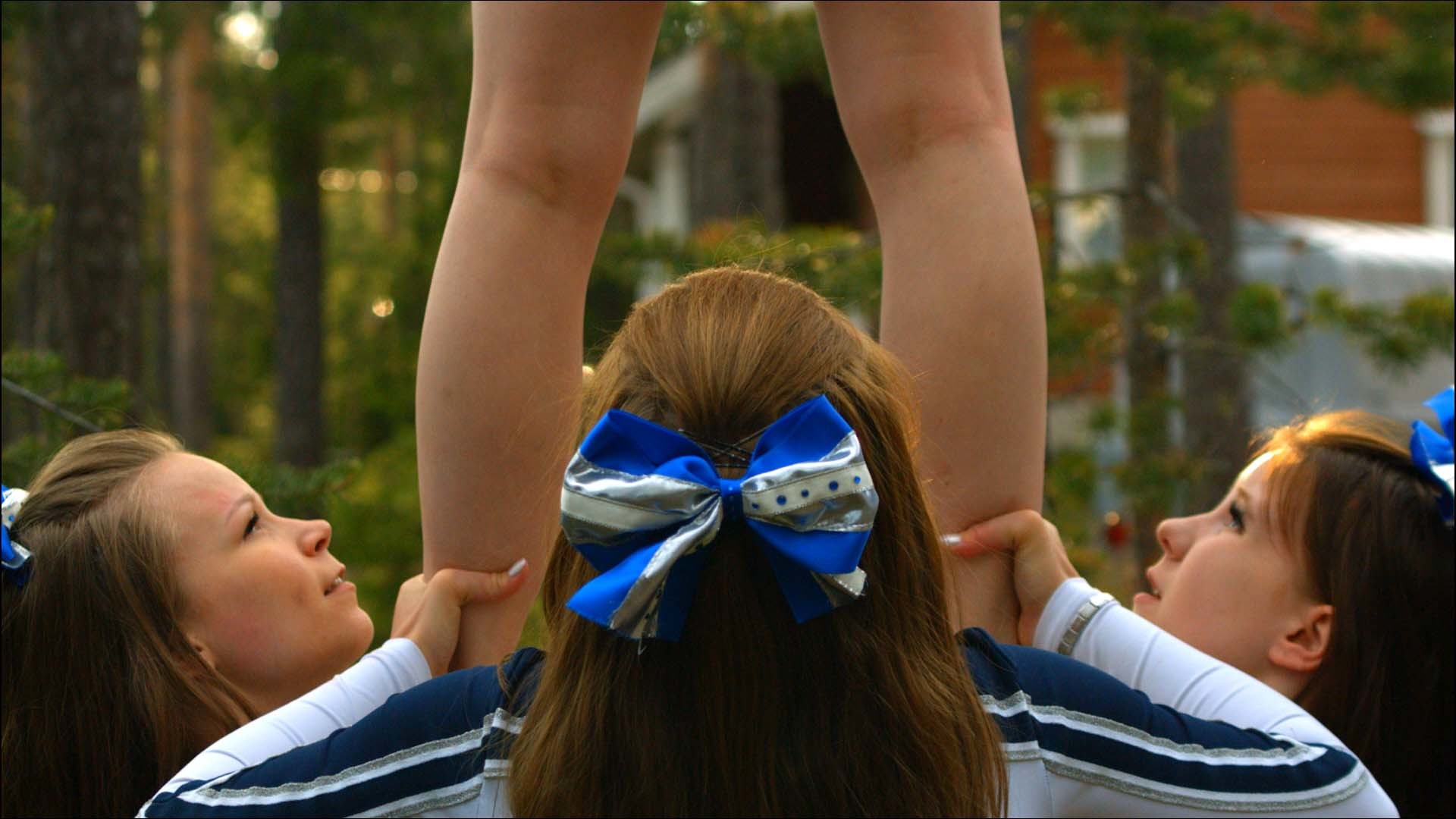With her ear stretchers, bottle black hair, and cigarette habit, Aino doesn’t look like your stereotypical cheerleader. As part of the Arctic Circle Spirit Cheerleaders’ Ice Queens, she’s a perfectly imperfect face of the brand. “It wasn’t bad, but you look like you’re at a funeral,” coach Miia tells the team at the start of Christy Garland’s new documentary about the hapless Finnish squad. They’ve just completed a lackluster practice session, one of their last before the national cheerleading qualifying competition in Oulu. “You all seem so depressed… Try to cheer up.” Spoiler: the Ice Queens don’t make the finals. In the Hollywood version of the film, they’d cheer up, eat clean, train dirty, and make it to the world championships. For Aino, Patricia, and Miia, the film’s three central characters, there’s another obstacle: finding something to actually cheer about. It’s not going to be Aino’s crush’s crappy punk band, Miia’s even crappier Tinder dates, or Patricia’s recently deceased mother.
Garland never set out to make a movie about cheerleaders. “I thought it was all short skirts and stupid smiles,” she says over the phone from Mexico a couple of weeks before the film’s premiere at Hot Docs in her native Canada. She certainly never set out to make a film about Finnish cheerleaders, but the Ice Queens turned out to be a perfect metaphor for what the director really wanted to explore: a deeper exploration of young women and the universal complications that they face in their personal lives. Over the last three years of the Ice Queens’ teenhood — the film finishes when Patsy and Aino are hitting 20 — Garland created a biting portrait of young womanhood in all its multi-faceted singularity. i-D spoke to the director about navigating her subjects’ surface pretensions, universal traumas, and (most importantly) their genuine sense of compassion.

You’re Canadian — was there a reason you decided to focus on a Finnish cheer squad?
I’d heard about this team in Finland through somebody I ran into somebody at an art opening. She was a former cheerleader, which I thought was rather interesting and kind of a strange thing to do with your life. She told me that she had consulted teams in Japan and China. She said, “There’s this team you probably don’t want to hear about up in the Arctic Circle in Finland, they’re kind of the worst team in the world.” Of course as a documentary filmmaker I thought that might be an interesting thing to pursue. But Finnish culture itself is sort of a great place to make a film about cheerleaders, because they’re a very reserved culture. They’re not huge smilers. Cheerleading isn’t the kind of thing you would expect to see in Finland. That’s what drew me to it. When I met this team, all of the young women were very smart but very quiet, and not effusive. So I thought it would be a really great way to explore this idea of women — cheerleaders, obviously, but also women — being expected to always look perfect, happy, successful, and on top of everything, while on the inside you’re dealing with all kinds of complicated life issues.
What were you finding dissatisfying about mainstream depictions of young womanhood?
I think I was finding — and certainly there are a lot of films and television programs that offer nuanced portraits of women — that there is a lot of general cattiness, really petty competitions, and humiliating judgments. Everything that we’re all really aware of existing in some reality TV. I just felt that sometimes it reduced women to this really petty mindset. I had been thinking about that and thinking that it would be nice to do a documentary about how wise and compassionate young women can be. That was kind of a vague thought, then when this stumbled into my path I thought, “Well that might work.” It ended up working well, especially when you learn what Patricia, Aino, and Miia, in particular, are going through. Myself and the producer and a lot of my friends all found that we identified strongly with all three of those characters.

Patricia is going through some particularly dark personal issues. How did you convince the girls to share their stories with you?
With Aino, I wrote her a long letter, and I told her that I really identified with her. What she understood then is that I really had a connection with her and I felt like her story was important and was worth telling. I found it a privilege to be able to follow where she was going and what she ended up doing. That’s how we established a relationship with her. Patricia, the young woman who is grieving the loss of her mother, she came around a little bit later. I think at first she just watched from afar, because I’d been shooting for a couple of years before she became one of the main characters. And her story actually has the biggest emotional wallop. She’s dealing with something we all have to deal with, which is the death of a parent. The definition of her family was changing and she had to decide whether accepting her father’s new baby was going to be a betrayal of her mother’s memory. I don’t think that story would have come out in the first year or so. I went [up to Finland] 14 times.
What was the reaction of the team when we first floated the idea for the film? Did you tell them you heard they were the worst team in the world?
I’m sure they’re probably still not thrilled with that phrasing being tossed around. Miia was the first one — we told her that we wanted to come up and make a film about her team because I’d also heard that she was really keen on trying to make the team better. She is an ambitious coach, and so it seemed to me like she was going to be on a learning curve. She was going to be trying to do something we all try to do, which is get better at what we love. So she was completely open to that. At first Aino wasn’t into having a camera shoved in her face all the time, but she seemed so important to me because for me it really shifts the model of what I was doing. If I was going to make a film about one or two of the cheerleaders, having one of them quit and leave the team at the beginning is kind of perfect, because her going off on her own journey to discover who she is and what she really wants before automatically being a joiner just really appealed to me.

How did you communicate with the girls who didn’t speak English or didn’t feel comfortable speaking English?
I was really blessed in that the producer is Finnish, and I had a really wonderful relationship with the cinematographer. She’s really important because, on top of being a really gifted cinematographer, once she got a sense of what angle I was taking on this story she was able to be my ears, and pass on what people were saying. She was able to translate what was happening with Aino being kicked off the team. Obviously I’m not going to be able to listen that well when I’m shooting, so she became a really important storyteller along with me.
As a society we have a sort of perverse obsession with watching people failing — and specifically with watching people falling. How does this play into the documentary?
To be honest, I get uncomfortable when I see those things, because that person could really hurt themselves. In the case of this film, they’re throwing each other 20 feet into the air. They do several somersaults and twists, and then when they land they have to trust that their teammates are going to catch them. That was another thing I loved about this sport. The fear of failure for them is also related to trust — at least for the fliers. Both Patricia and Aino are in positions of being fliers, which in the cheerleading world are the ones that get tossed up and they’re the ones at the top of the pyramid. It’s extremely difficult — it’s a very challenging sport. If there is a mistake, you could land on your head and get paralyzed. The stakes are high. So that fear of failure runs through the film, and they’re confronting that fear while also having to deal with their personal issues — who they are and how they relate to their peers. Because it is a film about family, but it’s also a film about how good and supportive women can be with each other. That’s sort of the message of the film — because when they come together at the end, regardless of whether they win or lose after working so hard to get better, they’re all so much closer. At the beginning everyone is totally alone. It’s pretty nordic and solitary.
http://widehouse.org/film/cheer-up
Credits
Text Hannah Ongley
Images courtesy of Wide House
